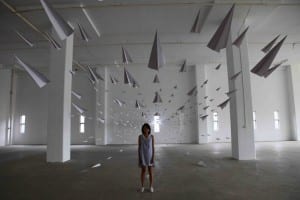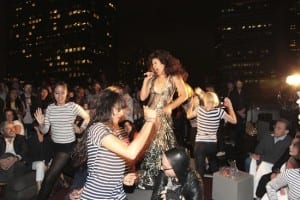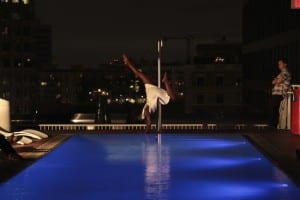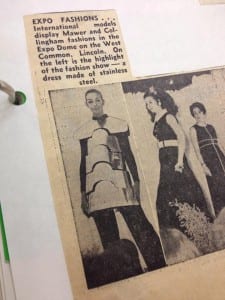Throughout the devising of our work we had toyed with the idea of creating an installation with the letters, airplanes and clocks that would be used within the performances. As we want to do several performances with gaps in between to reset the area we thought this time could also be spent building an installation. This would mean in every performance, the installation would look different. After the performances had finished we would have had an allotted time in which people could look at and explore the installation.
When looking at how we could structure the installation, we looked at work that was built using mainly paper. We discovered one piece of work that was made out of mainly paper.
This piece of work was very striking and we were inspired by how dynamic it looked. The idea of doing this with the airplanes flying away from the mural was one that we like a lot. However, after much deliberation we decided that this was not something we would be able to do in such a small space of time.
We then started to think what we had done at the grandstand through the previous weeks. Near the beginning of the process, we were asked to take a gift to the grandstand and we really liked the idea of leaving part of what we will be creating at the site even when we have left. I then suggested that we bury a time capsule containing elements of our show. This will happen after the main performances and will be filmed so it could be shared with those who won’t be there when it is buried.
We all agreed that this idea was one that we very much liked and decided to move forward with the idea. After a little more discussion, we decided that we would ask the other groups to add something into the capsule so it will be a collection of all of the performances that will take place on the 8th of May 2014.
We have also decided that at the end of each performance we will ask the audience to take the batteries out of the individual clocks and place them in a jar. This image of stopping time and then burying it at the site is one that we thought was very fitting with our piece. Asking the audience to stop the clock will be accompanied by this poem;
Stop all the clocks.
Stop all the clocks, cut off the telephone,
Prevent the dog from barking with a juicy bone,
Silence the pianos and with muffled drum
Bring out the coffin, let the mourners come.
Let aeroplanes circle moaning overhead
Scribbling on the sky the message He Is Dead,
Put crepe bows round the white necks of the public doves,
Let the traffic policemen wear black cotton gloves.
He was my North, my South, my East and West,
My working week and my Sunday rest,
My noon, my midnight, my talk, my song;
I thought that love would last for ever: I was wrong.
The stars are not wanted now: put out every one;
Pack up the moon and dismantle the sun;
Pour away the ocean and sweep up the wood.
For nothing now can ever come to any good.
W.H.Auden
Throughout the process we have been interested in this poem and how it relates really well to our site and especially the room we had chosen. At the end of the performance seems like the right place for the poem to go. We are now really excited about the image that this will create after each performance.
Works Cited- Dawn Ng: I fly like paper get high like planes, 2009. Auden, W.H., Stop all the clocks, 1938.





